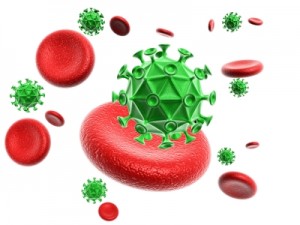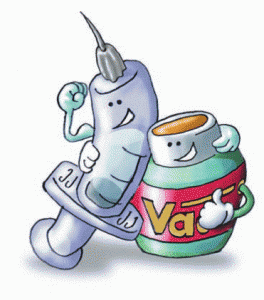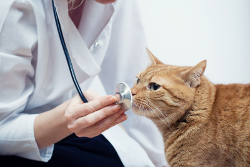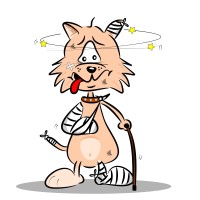Pneumonia is an inflammatory, infectious condition affecting the lungs. It can involve one portion of the lungs, or the lungs in their entirety. Foreign organisms invade the respiratory system by way of the nostrils or trachea and make their way to the alveoli, which are little branches and clusters of air sacks that make up lung tissue. This causes an immune response, Inflammation, pus, liquid, or other material forms in the lungs.
Cats can also develop aspiration pneumonia which is another means of fluid ending up in the lungs. Pneumonia is life-threatening if it is not addressed and treated in its early stages. Fortunately, it is not overly common in cats.
Causes of Pneumonia
 The two normal and extremely vital functions of the lungs are called ventilation and perfusion. Ventilation is the intake of oxygen from the surrounding air. Perfusion is when blood flows to the lungs, picks up the inhaled oxygen and delivers it into the system by way of circulation. Carbon dioxide, which is produced in the cat’s cells, is then exchanged for the fresh oxygen. Finally, the carbon dioxide is expelled by exhaling. Pneumonia occurs when this vital process is disrupted. There are two types of pneumonia with different causes.
The two normal and extremely vital functions of the lungs are called ventilation and perfusion. Ventilation is the intake of oxygen from the surrounding air. Perfusion is when blood flows to the lungs, picks up the inhaled oxygen and delivers it into the system by way of circulation. Carbon dioxide, which is produced in the cat’s cells, is then exchanged for the fresh oxygen. Finally, the carbon dioxide is expelled by exhaling. Pneumonia occurs when this vital process is disrupted. There are two types of pneumonia with different causes.
Infectious Pneumonia
Infectious Pneumonia: Results when viruses, bacteria, fungi or protozoa are inhaled, either from the environment or other cats. It can also result from an existing infection that is present elsewhere in the body. The infection may make its way into lung tissue. The prognosis for bacterial pneumonia is typically good if it is properly treated in a timely manner.
Aspiration Pneumonia
Aspiration Pneumonia: This type of pneumonia occurs when the cat inhales foreign matter or particles, causing irritation and an immune response. Episodes such as nearly drowning, inadvertent inhalation of vomit, or the incorrect administration of liquid medications are all ways a cat can develop aspiration pneumonia. It is important that if any medication or food must be given by a dose syringe, that it is given slowly and not plunged into the mouth faster than the cat can swallow.
Signs of Pneumonia
Clinical signs are the same in both types of pneumonia. They include:
- Fever
- Difficulty breathing
- Coughing
- Rapid pulse
- Yellow or green nasal discharge
In some cases, a crackling or rattling sound can be heard in the chest while the cat breathes. If the disorder has become severe enough to cause oxygen deficiency, the gums and mucous membranes in the mouth will have a dull gray or bluish tint. If you notice any signs of a respiratory nature, do not delay to alert your veterinarian.
As the pneumonia progresses, cats are at high risk for developing what is called systemic inflammatory response syndrome. This is when the inflammation in the lungs spreads to the rest of the body. This is a very serious condition that can result in multiple organ dysfunction.
Reaching a Diagnosis
The first step to any diagnosis is reviewing the cat’s complete medical history and performing a physical examination. Upon listening to the cat’s lungs with a stethoscope, the attending veterinarian may hear crackles, whistles and possibly some wheezing. When this happens, pneumonia is suspected.
A diagnosis of pneumonia is most often confirmed by a chest x-ray. After pneumonia is diagnosed, additional testing of the fluid in the lungs may be conducted to determine the best course of treatment.
The Treatment of Pneumonia
 Fortunately, most cases of pneumonia are treatable. The prognosis depends on many factors, including:
Fortunately, most cases of pneumonia are treatable. The prognosis depends on many factors, including:
- Underlying cause of pneumonia
- Age of the cat
- Overall health of the cat
- Other medical conditions present
Treatment begins with stabilizing the cat. Oxygen therapy may be necessary to stabilize breathing in a cat that is showing signs of respiratory distress.
Antibiotics
Antibiotics are prescribed immediately so they can begin clearing any bacterial infection. Hospitalization may be advised if the pneumonia has reached a critical stage. This way the cat can be properly monitored and supported while under treatment. To avoid dehydration, electrolytes may be administered intravenously.
Identification and Treatment
Finally, if a specific organism is identified to be causing the pneumonia, additional medication may be prescribed to treat the precise viral, fungal, or bacterial infection. The attending veterinarian may recommend repeating a chest x-ray at a later date in order to monitor the resolving pneumonia.
Home Recovery
At home, it’s important to restrict your cat’s activities while he is recovering or undergoing treatment. Sufficient rest is required but discourage your cat from laying in one position for more than two hours. Help him shift and then settle him back down to rest. Laying in the same position can cause the fluid in the lungs to accumulate in one spot.
Preventative Measure
The prevention of pneumonia is only possible to an extent. If your cat is kept safe from infectious diseases through routine immunizations and wellness exams, the risk of developing pneumonia is greatly reduced. Cases of severe pneumonia are preventable by alerting your veterinarian at the first signs of any respiratory abnormalities.
Thanks for visiting www.catdandruffclinic.com, if you liked this article please like us using the side bar .



Comments are closed.